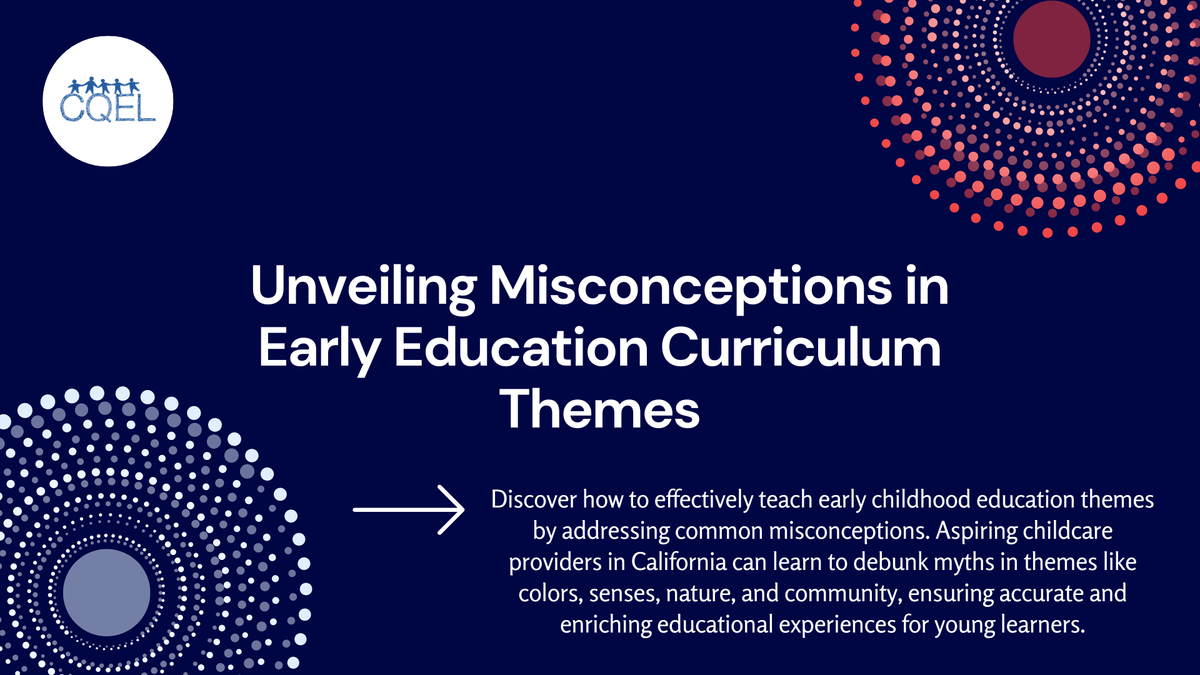Unveiling Misconceptions in Early Education Curriculum Themes
Learn about common misconceptions in teaching themes like colors, senses, nature, and community, and how aspiring childcare providers in California can debunk these myths for accurate, enriching experiences.

In the dynamic landscape of early childhood education, curriculum themes serve as pivotal avenues for fostering exploration, discovery, and understanding among young learners. Themes such as colors, the five senses, nature, and community provide rich opportunities for children to engage with the world around them. However, amidst the excitement of teaching these themes, it's crucial for aspiring childcare providers in California to recognize and address common misconceptions that may inadvertently find their way into the curriculum. By debunking these myths, educators can ensure that children receive accurate and enriching educational experiences that lay a solid foundation for future learning.
Color Theme Misconceptions
In the vibrant world of colors, one common misconception is the belief that primary colors—red, blue, and yellow—are the most important ones that exist. However, this overlooks the rich spectrum of secondary and tertiary colors created through blending and mixing. By introducing children to the principles of color theory and engaging them in hands-on activities like color mixing experiments, educators can expand their understanding and appreciation of the diverse palette around them. Moreover, dispelling the notion that certain colors are inherently gendered—such as pink for girls and blue for boys—promotes inclusivity and allows children to express themselves freely without societal constraints.
Resources:
- Color Mixing Activities for Preschoolers: https://www.pre-kpages.com/color-mixing-activities-for-preschoolers/
- Gender-Neutral Toys and Activities: https://www.naeyc.org/resources/pubs/tyc/feb2018/gender-neutral-toys
Five Senses Theme Misconceptions
While it's commonly taught that humans have five senses—sight, hearing, taste, smell, and touch—the reality is far more nuanced. In addition to these primary senses, children also experience proprioception, which allows them to sense body position and movement, and vestibular sense, which contributes to balance and spatial orientation. By incorporating activities that engage all these sensory systems, educators can provide a holistic understanding of how humans perceive the world. Furthermore, challenging the idea that each sense operates independently encourages children to explore the interconnectedness of sensory experiences and appreciate the complexity of their sensory perceptions.
Resources:
- Sensory Activities for Preschoolers: https://www.preschoolinspirations.com/sensory-activities-for-preschoolers/
- Exploring the Senses in Early Childhood: https://www.zerotothree.org/resources/1079-exploring-the-senses-in-early-childhood
Nature Theme Misconceptions
In the exploration of nature, misconceptions often arise regarding the roles and perceptions of insects and plants. While some may view bugs as solely creepy or harmful, fostering an appreciation for their ecological significance promotes environmental stewardship and respect for all living creatures. Additionally, dispelling the notion that plants are static entities devoid of sensitivity or response to their environment opens the door to discussions on adaptation, growth, and the intricate web of life. Through hands-on experiences like gardening and insect observation, children can develop empathy and curiosity towards the natural world that surrounds them.
Resources:
- Gardening Activities for Preschoolers: https://kidsgardening.org/gardening-activities-for-preschoolers/
- Teaching Children to Respect Nature: https://www.naeyc.org/resources/pubs/yc/may2018/respecting-nature
Community Theme Misconceptions
Within the community theme, it's essential to challenge misconceptions surrounding societal roles and structures. Rather than portraying professions like police officers and firefighters in simplistic terms of "good" and "heroic," educators can facilitate nuanced discussions that acknowledge the complexities and diversity within these fields. Similarly, broadening children's perspectives on housing beyond the traditional concept of houses fosters cultural awareness and appreciation for the multitude of living arrangements that exist. By exploring diverse community roles and living environments, children gain a more comprehensive understanding of the world they inhabit and the people who shape it.
Resources:
- Community Helpers Activities: https://www.prekinders.com/community-helpers-theme/
- Exploring Diversity in Community Themes: https://www.naeyc.org/resources/pubs/yc/jan2017/exploring-diversity-in-community-themes
In the journey of early childhood education, it's imperative for aspiring childcare providers in California to critically examine and address misconceptions within preschool curriculum themes. By debunking myths surrounding colors, the senses, nature, and community, educators pave the way for children to develop accurate understandings of the world around them. Through intentional teaching practices and a commitment to fostering curiosity and critical thinking, educators can empower young learners to embrace knowledge with clarity and confidence, laying the groundwork for a lifetime of learning and exploration.
